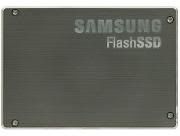 Solid State Drives (SSDs) are data storage devices much like Hard Disk Drives (HDDs), but uses solid-state flash memory to store data. The Gigabyte i-RAM is sort of like SSD, but instead uses RAM; more specifically, DDR RAM.
Solid State Drives (SSDs) are data storage devices much like Hard Disk Drives (HDDs), but uses solid-state flash memory to store data. The Gigabyte i-RAM is sort of like SSD, but instead uses RAM; more specifically, DDR RAM.
X-bit Labs tested the following:
- 32GB Samsung (MCAQE32G5APP-0XA) SSD with UDMA66 interface
- 64GB Samsung (MCAQE32G5APP-0XA) SSD with SATA interface
- Gigabyte i-RAM with SATA interface
- 200GB 2.5" Hitachi 7K200 HDD with SATA interface
- 1000GB 3.5" Samsung SpinPoint F1 HDD with SATA interface
- 300GB 3.5" Fujitsu MBA3300RC HDD with SCSI interface
"In real-life applications SSDs are going to be faster than 2.5" HDDs with a spindle rotation speed of 5400rpm unless the manufacturer installs very slow chips of flash memory into them. ... SSDs are also considerably faster than 3.5" HDDs in terms of random reading but slower at sequential reading. ... So, hard disk drives still remain the best choice in terms of price, capacity and speed combined when it comes to the disk subsystem of a workstation, file server and write operations-oriented server." [X-bit Labs | SSD, i-RAM and Traditional Hard Disk Drives]
The i-RAM does perform well, but its limited capacity (4GB), and its temporary retention of data (data is lost when its battery backup gets depleted) is not yet a legitimate contender against the hard disk drive.
As it turns out, SSDs are fast drives, and require less power than conventional hard drives. And users will definitely appreciate the silent operation of SSDs. The somewhat high price of SSDs is probably the real reason why it is not (yet) the mainstream storage device.



0 comments:
Post a Comment